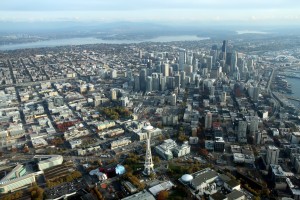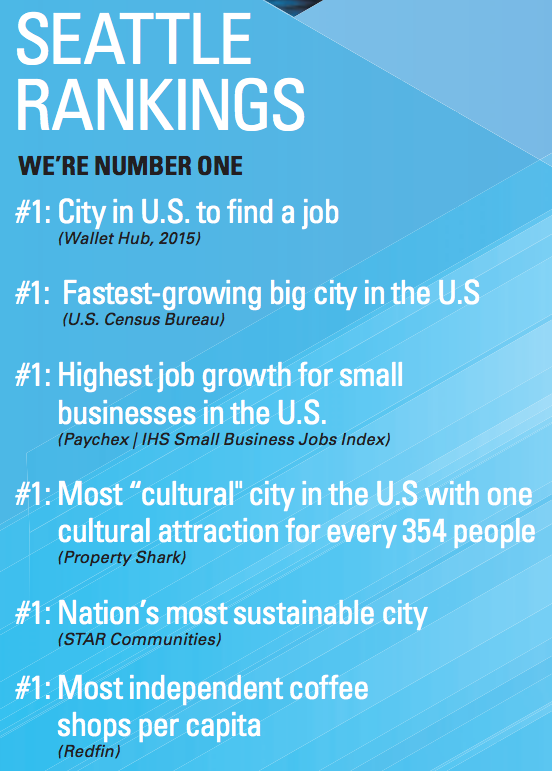
The Downtown Seattle Association released their 2015 State of Downtown Economic Report and things are looking good. We’re number one in, well, a lot: sustainability, small business job growth, population growth, and independent coffee shops (naturally).
The report tracks five-year growth in key areas, from jobs to housing and from tourism to transportation. It makes clear that Downtown is an active, thriving area that has made a strong recovery from the recession. We’re adding approximately 24 residents every week and 25 jobs every day.
Downtown, defined liberally as everything from SODO to Lower Queen Anne and Capitol Hill, is the economic engine of the region. Below is a breakdown of the 28-page document:
Transportation
The report shares findings from the recently released Downtown Seattle Commuter Trends survey by Commute Seattle. For starters, we’re one of only six cities in which fewer than half of commuters drive to work alone (31%), while 45%(!) take transit.
It also celebrated key transit projects in the area, including the near completion of the First Hill Streetcar, now delayed until August; planning for the City Center Connector, a streetcar with dedicated lanes connecting the SLU and First Hill lines; and 52.3 miles of bike lanes, shared lanes, and trails for people who bike.
Population
Simply put, it’s booming. Downtown has experienced eight-percent growth since 2010 compared to five-percent citywide, with another ten-percent expected by 2020. The area already has twice the residential density of the citywide average (triple if SODO is excluded).
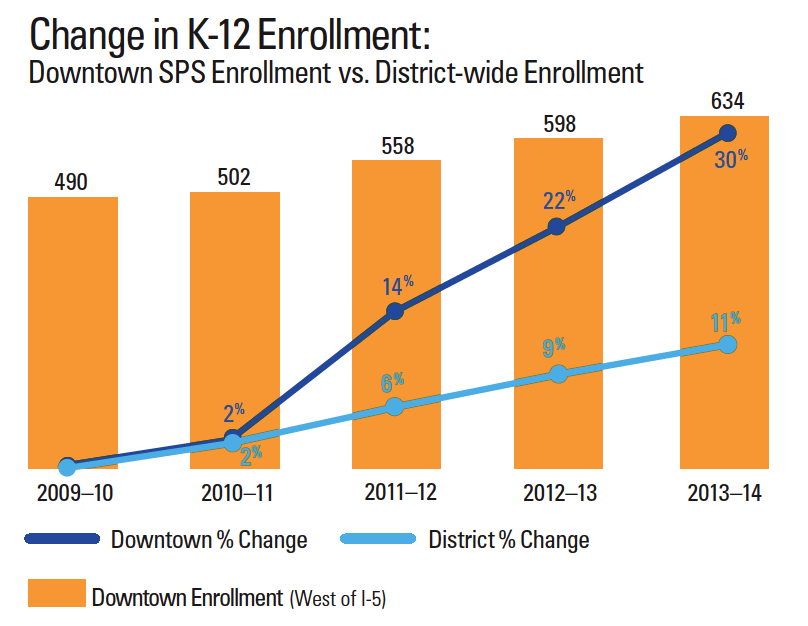 The typical Downtown resident is renting (81%), living alone (68%), and highly educated (53% with a bachelor’s degree or higher). There’s also a 30% chance they work Downtown, though several major transportation projects may change that.
The typical Downtown resident is renting (81%), living alone (68%), and highly educated (53% with a bachelor’s degree or higher). There’s also a 30% chance they work Downtown, though several major transportation projects may change that.
People tend to live within a 30-minute commute. With the Link light rail expansion opening in early 2016, travel times from Downtown to Capitol Hill will be just three minutes, and six to UW. A revived passenger ferry from Bremerton will cut travel time there in half, to a mere 35 minutes. But without increased housing supply, they’ll be unlikely to see the benefit of closer proximity.
A major focus was the growing presence of children. A mere four percent of households have kids, though that number has grown seventeen percent since 2010. And while Downtown lacks the school infrastructure, growth in K-12 enrollment from downtown is triple that of the district average (11%).
Housing
Downtown is a renters’ market, with apartments outnumbering condos four-to-one. Supply is keeping up with demand, seeing ten-percent growth since 2010—though new construction appears to be tapering off with only 2700 new units scheduled to be under construction in 2016, down from 3400 in 2014.
Most units are studios or one-bedrooms (73%). They’re compact, too, averaging 638 square feet for an apartment and 913 square feet for a condo.
Market vacancy has fallen to below 4%, with rents continuing to climb. The average rent in 2010 was below $1500. Now it stands at $1906, compared to $1485 citywide and $1338 countywide.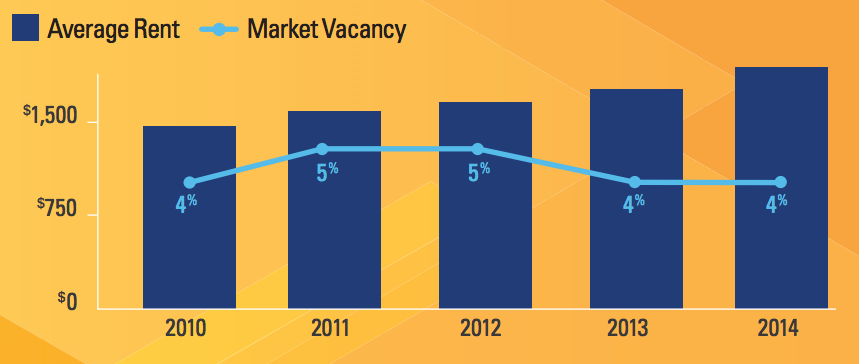
Jobs
Nearly a quarter million people work in Downtown, accounting for half of all jobs in the City and 21% of all jobs in King County. There is over 44 million square feet of office space—that’s half of all the office space in the Puget Sound region—and another 15 million in development. Amazon accounts for about a third of that new development, with 5 million square feet in development, almost exclusively in South Lake Union.
The workforce is dominated by the service industry, representing 144,100 jobs (59%). The Public sector is a distant second with 33,200 jobs (14%), followed by finance, insurance, and real estate with 23,600 jobs (10%) and retail with 22,600 jobs (9%).
Pedestrians
Pedestrian traffic is up a remarkable 35% since 2010, with the largest increases in the retail core and in South Lake Union around Amazon. The International District also saw an uptick in summer traffic, likely correlating to a summer Seahawks game.
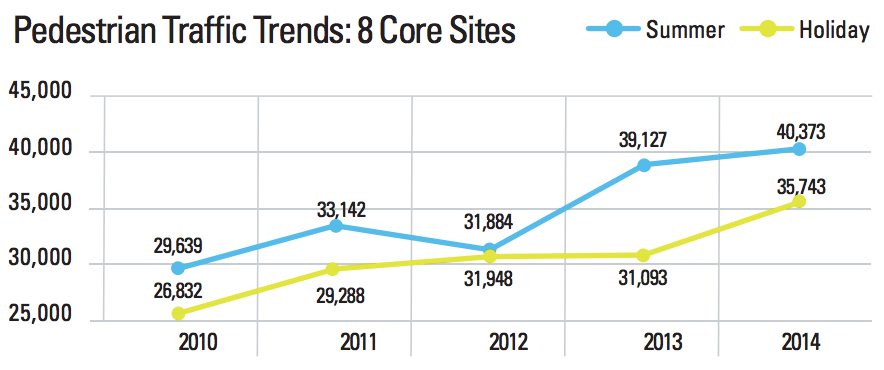 Seattle’s newly adopted Vision Zero plan aims to eliminate all citywide traffic deaths and serious injuries by 2030. Part of the plan calls reducing speed limits downtown where most collisions occur. That’s good news for pedestrians, who are often on the losing side of a collision with a multi-ton metal vehicle.
Seattle’s newly adopted Vision Zero plan aims to eliminate all citywide traffic deaths and serious injuries by 2030. Part of the plan calls reducing speed limits downtown where most collisions occur. That’s good news for pedestrians, who are often on the losing side of a collision with a multi-ton metal vehicle.
Activities
Healthy cities have an abundance of activities and cultural events to enrich the lives of its residents, and Seattle has no shortage. In 2014, Downtown saw over 23 million attendees to more than 4,000 major events, museums, and attractions.
The report provides top reasons we’re such a hot spot for visitors: we’re one of the most walkable cities, we have easy transit access (especially light rail from the airport), we have diverse food establishments and boutique shops, and we have gorgeous natural scenery.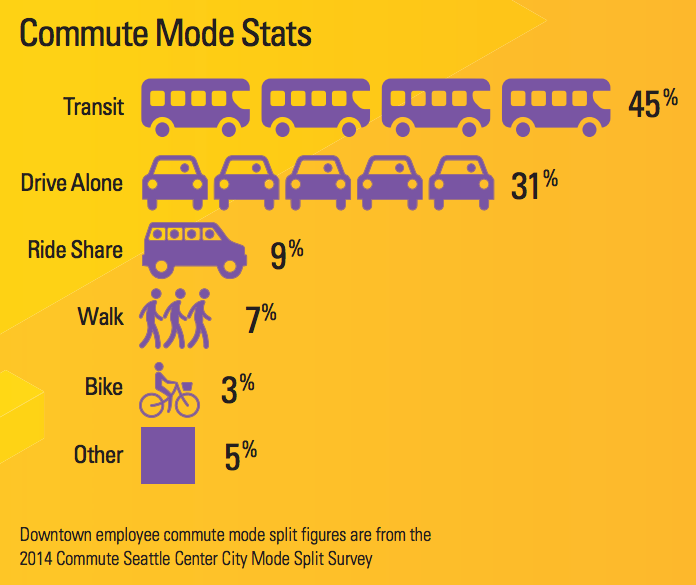
Conclusion
Indeed, these are the very features we at The Urbanist fight to protect and expand. We know that cities do best when they’re active, accessible, and stimulating.
Downtown represents much of the best of urban living. It fosters the development of young, highly educated residents and business startups in tech, life sciences, and gaming. It offers a robust, multi-modal transit system with quality light rail, an expanding streetcar system, a burgeoning bikeshare program, and wide sidewalks. And it offers active streetscapes with engaging street-level businesses.
Our density is what facilitates all of this development. Density creates efficiency; it fosters interactions that spark innovations; it allows for the kind of specialization and niche building that build a thriving and exceptional culture.
Good urbanism isn’t and can’t be isolated to Downtown. We’re working to encourage smart, sensible development where it belongs; we’re fighting for vital pedestrian infrastructure in Northgate; we’re calling on legislators to expand light rail throughout the region and expand our streetcar system within the city; we want active streetscapes that prioritize the needs of people who walk, cycle, take transit, and drive; and we want affordable housing so more people can enjoy our beautiful city. When areas like Downtown thrive, so does the rest of the City and the region.

Ben Crowther
Ben is a Seattle area native, living with his husband downtown since 2013. He started in queer grassroots organizing in 2009 and quickly developed a love for all things political and wonky. When he’s not reading news articles, he can be found excitedly pointing out new buses or prime plots for redevelopment to his uninterested friends who really just want to get to dinner. Ben served as The Urbanist's Policy and Legislative Affairs Director from 2015 to 2018 and primarily writes about political issues.

